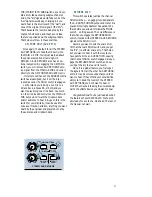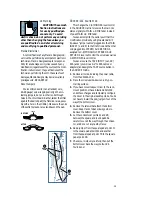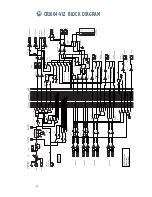
15
MAIN INSERT
These
1
/
4
" jacks are for connecting serial
effects such as compressors, equalizers, de-
essers, or filters . The
INSERT
point is after
the mix amps, but before the
MAIN L-R MIX
fader.
Insert cables must be wired thusly:
“tip”
This plug connects to one of the
mixer’s Channel Insert jacks.
“ring”
tip
ring
sleeve
SEND to processor
RETURN from processor
(TRS plug)
Tip = send (output to effects device)
Ring = return (input from effects device)
Sleeve = common ground (connect shield to
all three sleeves)
MAIN OUTS
These
1
/
4
" jacks are usually patched to the
inputs of your 2-track mixdown deck (unless
you’ve chosen to use the
TAPE OUTPUT
RCA
jacks), or to the house amplifier during live
sound sessions.
To learn how signals are
routed to these outputs:
. To use these out-
puts to drive balanced inputs, connect
1
/
4
" TRS
(Tip-Ring-Sleeve) phone plugs like this:
Tip = + (hot)
Ring = – (cold)
Sleeve = ground
To use these outputs to drive unbalanced
inputs, connect
1
/
4
" TS (Tip-Sleeve) phone
plugs like this:
Tip = signal
Sleeve = ground
MONO OUTPUT
It happens to everybody sooner or later:
The forces that govern your world will demand
a monaural output from your painstakingly-
created stereo panorama. The last thing you
want to do is start twirling all your carefully-
placed
PAN
settings to one side. What to do?
Stick a cord in this
1
/
4
" jack, hand the other
end to Mr. Mono, and you’re done. He’s got his
mono mix and you’ve still got your stereo mix.
The
MONO
output is nothing more than a mix
of the left and right
MAIN MIX
.
MONO LEVEL
So, Mr. Mono comes running back, scream-
ing about the mono mix being so loud that his
camcorder is melting. Just reach for this knob
and turn it down a bit. Just the thing for send-
ing mono signals to mic inputs like camcorders,
telephone interface boxes, even answering
machines. With the pot all the way up (fully
clockwise), you’ll have 6dB of extra gain with
unity gain halfway between the one and two
o’clock positions.
POWER CONNECTION
Just in case you lose the cord provided with
the CR1604-VLZ, its power jack accepts a stan-
dard 3-prong IEC cord like those found on
most professional recorders, musical instru-
ments, and computers. At the other end of our
cord is — get this — a plug! Not a black cube
or, as we’re fond of calling them, a “wall wart.”
We did this for some very good reasons:
The CR1604-VLZ has sophisticated power
requirements that a wall wart cannot provide.
Wall warts are inconvenient, fragile, radiate huge
hum fields, hog extra jacks on your power strip
and get in the way. If you lose a wall wart, you’re
in trouble, but if you lose the CR1604-VLZ’s power
cord, you can get a new one at any electronics,
music, or computer store. You can even buy them
at Radio Shack
®
(part # 278-1257).
Plug the CR1604-VLZ into any standard
grounded (3-pin) AC outlet or into a power
strip of proper voltage.
WARNING: Disconnecting
the plug’s ground pin can
be dangerous. Please
don’t do it.
FUSE
The CR1604-VLZ is fused for your (and its
own) protection. If you suspect a blown fuse,
disconnect the power cord, pull the fuse drawer
out (located just below the cord receptacle)
and replace the fuse with a 1A SLO BLO, 5x20mm,
available at electronics stores or your dealer
(or a 500mA [0.5 amps] SLO BLO 5x20mm if
your CR1604-VLZ is a 220V-240V unit).
SLEEVE
TIP
SLEEVE
TIP
RING
RING
TIP
SLEEVE
RING
SLEEVE
TIP
TIP
SLEEVE
TIP
SLEEVE
O
O
+6
PHANTOM
POWER
120 VAC 50/60 Hz 20W
315mA/250V SLO-BLO
16
15
14
13
12
11
10
MIC 16
INSERT
INSERT
INSERT
INSERT
INSERT
INSERT
INSERT
MIC 15
MIC 14
MIC 13
MIC 12
MIC 11
MIC 10
C-R OUTS
MAIN INSERT
TAPE
TAPE
MAIN OUT
R
L
MONO
R
L
R
L
R
L
R
L
BAL/UNBAL
BAL/UNBAL
INPUT
OUTPUT
BAL
UN-
BAL
BAL
UN-
BAL
BAL
UN-
BAL
BAL
UN-
BAL
BAL
UN-
BAL
BAL
UN-
BAL
BAL
UN-
BAL
LINE
LINE
LINE
LINE
LINE
LINE
LINE
TO REDUCE THE RISK OF
FIRE REPLACE WITH SAME
TYPE FUSE AND RATING
CAUTION:
















































